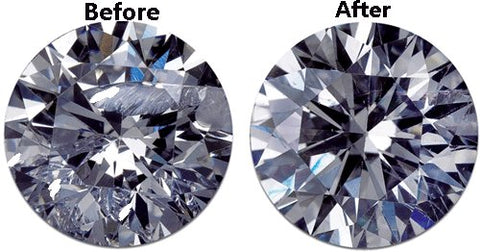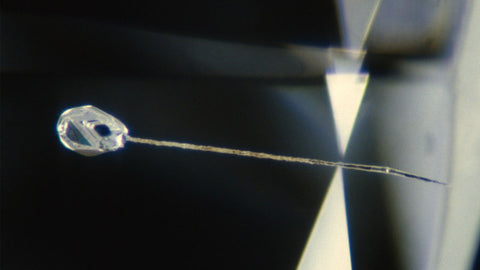What is a Clarity Enhanced Diamond?

History of Enhanced Engagement Rings
Emeralds, rubies, sapphires, tanzanite, citrine, topaz, and many other gemstones have been treated to improve the visual appearance for hundreds for years. It wasn’t until the 1980's when Zvi Yehuda invented a new way to enhance the optical clarity of natural diamonds. This revolutionary method has made diamonds more affordable than untreated diamonds for shoppers while still maintaining the brilliance and durability that diamonds are known for.
What is a Clarity Enhanced Diamond
The term “clarity enhanced” is merely a phrase to describe the process of treating a real (natural) diamond and improving the visual clarity. A clarity enhanced diamond may undergo one or more methods to achieve maximum brilliance, but the two most common ways are fracture filling and laser drilling.
Almost every diamond contains inclusions, which are also known as imperfections or flaws. The amount and location of inclusions in a particular diamond affects its clarity grade, which is a measurement to gauge how flawless a diamond is.
All things equal, the less flaws in a diamond the more expensive it is. However, it is now possible to repair these imperfections and leave you with a stone that is just as brilliant as a more expensive diamond. Typically, a clarity enhanced diamond costs 40%-60% less than a visually comparable non-enhanced diamond which makes them an extremely popular option when shopping for a diamond engagement ring or stud earrings.
Are They Real Diamonds?
Yes! This process is applied to natural diamonds to fix naturally occurring flaws or flaws revealed from the process of cutting and polishing the diamond.
Fracture Filling
This proprietary method is commonly referred to as clarity enhanced and can only repair a specific type of natural diamond inclusion. This inclusion referred to as “a feather,” may form naturally in the diamond or occur as a result of the extreme stress of cutting and polishing.
Feathers get their name from the white and feathery appearance in the diamond. When light hits the feather, it stops rather than bounces, which prevents the diamond's signature sparkle.
During the fracture filling process, the diamond and glass-like material containing bismuth are put in a vacuum container. The process fills the feather with a microscopic amount of material with the same refractive index (2.417) as the diamond. Since the treatment has a similar refractive index as the diamond, light is allowed to pass through the flaw, rendering it virtually invisible and allowing the diamond to reflect light better.
The treatment is exceptionally long-lasting, stable and is only reversible with strong acids, bases, or exposure to temperature over 1500°. In the extremely rare event that your fracture filled diamond needs retreating, the Mikado Diamonds lifetime warranty will cover re-enhancement at no additional cost.
Fracture filled diamond before and after clarity enhancement.

Laser Drilling
Another conventional method of treating clarity-enhanced diamonds that have a non-surface reaching flaw is with an infrared laser. During treatment, the laser disintegrates or disperses a solid internal inclusion within the diamond.
Then, the laser drills a tiny “tunnel” into the diamond to reach the internal inclusion. After hitting the flaw, the diamond is treated with heat or acid to dissolve the internal imperfection. The size of the laser is smaller than a strand of hair and does not interfere with the integrity of the diamond. GIA has deemed this process as permanent and typically improves the clarity grade of the diamond by one or two grades.
The laser drilled holes are sometimes noticeable without the aid of a 10x loupe when viewed through the pavilion. The facets may even reflect the drill hole making it appear as multiple holes. In some cases, the holes may even be treated with a filling compound to make the hole less visible. Once a laser-drilled hole is filled, the Federal Trade Commission (FTC) requires that the treatment be disclosed.
Round brilliant cut diamond, shown at 63x magnification, has been laser drilled to remove an inclusion.

Courtesy of GIA: This 3.28 ct round brilliant cut diamond, shown at 63x magnification, has been laser drilled to remove an inclusion.
Grading Clarity Enhanced Diamonds
Depending on the type and location of the flaws that were treated, the enhancement process can improve the visual clarity an average of 2 clarity grades. The clarity grade is based on the visual appearance after the diamond has been enhanced.
GIA does not issue grading reports for clarity enhanced diamonds because fracture filling is considered a non-permanent process. It is considered non-permanent due to the ability to reverse with strong bases, acids, or exposure to heat over 1500°; however, GIA confirms that the clarity enhancement process is stable under normal wear and tear. GIA will issue reports for diamonds that have been laser drilled with disclosure of the treatment on the grading report. There are many independent labs that do provide grading reports for clarity enhanced diamonds and all diamonds sold by Mikado Diamonds are accompanied by a grading report from an independent lab.
If an Enhanced Diamond Looks the Same why Does it Cost Less?
The value of the diamond is determined in it's natural state prior to enhancement. That means you are paying the price for the diamond as if it was still flawed. The process of enhancing the diamond does not change the underlying value of the diamond. Click here to read more about diamonds in general and Clarity Enhanced Diamond Value. Click here to read more FAQ about Clarity Enhanced Diamonds.
How Much Weight Does the Enhancement Add
The amount of substance used in fracture filling is so small that it adds virtually no weight to the diamond.
Will the Diamond Color Change Over Time
The process of fracture filling or laser drilling to improve clarity does not change the actual color of the diamond; therefore, the color of a clarity enhanced diamond will not change over time. GIA confirms that the clarity enhancement process is stable under normal wear and tear.
Can Flaws Still Be Seen After Treatment
The treated flaws in the diamond are made less visible but will still be recognized by a trained gemologist under 10x magnification.
How Can I Tell if a Diamond is Clarity Enhanced?
Regardless of the treatment method, the Federal Trade Commission (FTC) requires proper disclosure of any treatment to a gem material that substantially affects its value. All of the rings and loose diamonds sold by Mikado Diamonds have clear disclosure in the product details section.
What Precautions are Needed to Protect a Clarity Enhanced Diamond
Let your jeweler know the diamond is clarity enhanced before having any work performed on your engagement ring or earrings. A trained bench jeweler can perform most work, including cleaning, polishing, and sizing with proper precautions taken to protect the diamond from being heated above 1500°. Certain repairs like re-tipping prongs may require temporary removal of the diamond while work is being performed.
Mikado Collection
Hand Crafted Engagement Rings, Loose Natural and Lab-Grown Diamonds and a Fashion Jewelry Collection of Rings, Necklaces, Bracelets, and Earrings.

Complete Engagement Rings
Choose a ring with a diamond hand selected by a trained jeweler.


Loose Diamonds
Shop a huge selection of certified natural or lab-grown diamonds. On Sale Now!

Fashion Jewelry
Fashion rings, necklaces, bracelets & earrings. Take your style to a new level.




Comments